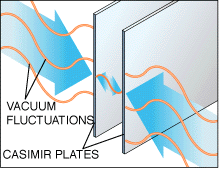Casimir effect

The Casimir effect is a small attractive force that acts between two close parallel uncharged conducting plates. Its existence was first predicted by the Dutch physicist Hendrick Casimir in 19481 and confirmed experimentally by Steven Lamoreaux, now of Los Alamos National Laboratory, in 19962, 3.
The Casimir effect is one of several phenomena that provide convincing evidence for the reality of the quantum vacuum – the equivalent in quantum mechanics of what, in classical physics, would be described as empty space.
According to modern physics, a vacuum is full of fluctuating electromagnetic waves of all possible wavelengths which imbue it with a vast amount of energy, normally invisible to us. Casimir realized that between two plates, only those unseen electromagnetic waves whose wavelengths fit a whole number of times into the gap should be counted when calculating the vacuum energy. As the gap between the plates is narrowed (to a few nanometers), fewer waves can contribute to the vacuum energy and so the energy density between the plates falls below the energy density of the surrounding space. The result is a tiny force trying to pull the plates together – a force that has been measured and thus provides proof of the existence of the quantum vacuum.
Pushes, pulls, and nanotechnology
Casimir's original theory applied only to ideal metals and dielectric materials; however, in the 1950s and '60s, the Russian physicist Evgeny Lifshitz extended Casimir's theory to include real metals and found that the forces at work could be repulsive as well as attractive. Because of his contribution, the Casimir effect is now also known as the Casimir–Lifshitz effect.
To date, only the attractive form of the effect has been studied in detail and without any immediate practical application. But the emergence of nanoscale devices has brought to light a drawback of the Casimir–Lifshitz effect: it can cause tiny pieces of machinery, such as microscopic cogs, to stick together. As such devices continue to shrink, the consequences of the effect will need to be taken seriously.
One possibility, explored by Federico Capasso of Harvard University and his coworkers,4 is to exploit the repulsive Casimir–Lifshitz effect to make nanomachines run more easily. Instead of vacuum between metal plates, Capasso's team used a liquid, bromobenzene, as the separating medium, and a gold-coated polystyrene sphere attached to a cantilever, and a silica plate. The key to the experiment is the dielectric permittivity of each of these materials. This property represents a material's ability to carry an electric field. To get a repulsive force out of the system, the dielectric permittivity of one plate must be higher than that of the surrounding liquid, and the dielectric permittivity of the second plate must be lower than that of the surrounding liquid. In the arrangement used by Capasso's group, gold has the highest dielectric permittivity, followed by bromobenzene, followed by silica. The Casimir-Lifshitz force works so that the liquid is attracted into the gap between the two, forcing them apart.
Casimir effect and propulsion
The Casimir effect has been linked to the possibility of faster-than-light travel because of the fact that the region inside a Casimir cavity has negative energy density. Zero energy density, by definition, is the energy density of normal "empty space." Since the energy density between the conductors of a Casimir cavity is less than normal, it must be negative. Regions of negative energy density are thought to be essential to a number of hypothetical faster-than-light propulsion schemes, including stable wormholes and the Alcubierre warp drive.
There is another interesting possibility for breaking the light-barrier by an extension of the Casimir effect. Light in normal empty space is "slowed" by interactions with the unseen waves or particles with which the quantum vacuum seethes. But within the energy-depleted region of a Casimir cavity, light should travel slightly faster because there are fewer obstacles. A few years ago, K. Scharnhorst of the Alexander von Humboldt University in Berlin published calculations5 showing that, under the right conditions, light can be induced to break the usual light-speed barrier. Under normal laboratory conditions this increase in speed is incredibly small, but future technology may afford ways of producing a much greater Casimir effect in which light can travel much faster. If so, it might be possible to surround a space vehicle with a "bubble" of highly energy-depleted vacuum, in which the spacecraft could travel at FTL velocities, carrying the bubble along with it.
References
1. Casimir, H. G. B. "On the attraction between two perfectly conducting
plates." Proc. Con. Ned. Akad. van Wetensch B51 (7): 793-796
(1948).
2. Lamoreaux, S. K. "Demonstration of the Casimir force in the 0.6 to
6 mm range." Physical review Letters 78 (1): 5-8 (1997).
3. Schwinger, J. "Casimir light: The source." Proceedings of the National
Academy of Science, 90: 2105-6 (1993).
4. Munday, J. N., Capasso, F. & Parsegian, V. A. Nature 457,
170-173 (2009).
5. Scharnhorst, K. Physics Letters B236: 354 (1990).


